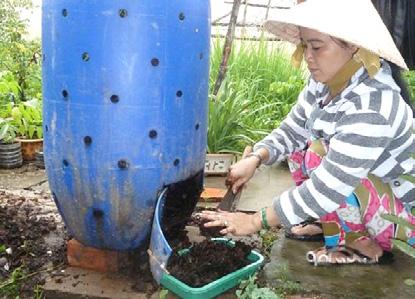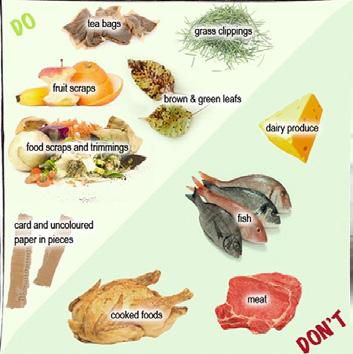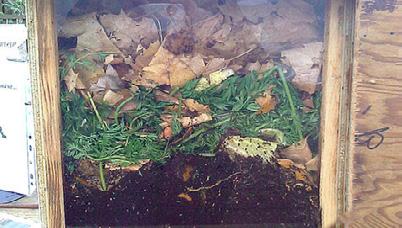
4 minute read
Making organic fertilizer at home
from [New version] Gardening - Easy or Not?
by Trung Tâm Phát triển Sáng kiến Cộng đồng và Môi trường C&E
Organic fertilizers are fertilizers containing nutrient compounds which are mainly organic compounds. They are derived from animal excreta (manure), peat, agricultural waste (ash, leaves, branches, etc.) or garbage. Organic fertilizers are used to grow vegetables without toxic chemicals, as they contain nutrients which are easily absorbed by plants and friendly to the environment. Organic fertilizers are specifically beneficial to families who would like to grow vegetables without toxic chemicals at home. Therefore, making organic fertilizers at home is a both efficient and moneysaving practice.
Organic fertilizers can be divided into three following categories
Advertisement
TRADITIONAL ORGANIC FERTILIZERS
Main sources of this type include animal waste, agricultural waste, compost and filler. Once these materials have gone through traditional process, they can be used for plants, fruit trees or leafy vegetables. Organic content accounts for more than 22%.
BIO-ORGANIC FERTILIZERS
They are industrially processed fertilizers. The main sources are similar to those of traditional organic fertilizers and sometimes have more peat. Bi-organic fertilizers are produced with industrial formulas and process. Some biological compounds included are humic acid, humin and amino acids.
MICROBIAL ORGANIC FERTILIZERS
They are also industrially processed fertilizers. The sources of ingredients are similar to those of bioorganic fertilizers but the final products contain one or more types of micro-organisms beneficial to plants which will operate after the fertilizers are applied.
How to make simple organic fertilizers from familiar sources
The technique of making organic fertilizers is not too complicated, so households, groups of households, cooperatives and larger scale companies are all able to make them from domestic waste. Be noted that as waste has high moisture content, heterogeneous organic matter composition and high carbon content which makes it difficult to decompose; the procedure is divided into two phases,
composting organic waste for fermentation and deep processing of fermented waste. There are various types of containers for organic fertilizers such as closed containers (prolonging the process, though), wooden barrels, plastic containers and containers with capacity of 20-120l (depending on the household’s amount of waste).
STEP 1: FIND THE APPROPRIATE LOCATION
The ideal locations are well-ventilated places with plenty of sunlight for “heating” the compost for shortened incubation time. Arrange the compost near water sources so that it would be easier to moisturize it.

Put the fertilizer in open space (Photo: Cachtrongrausach)
Note: Meat and fish are potential sources but should be avoided as they usually contain pathogens. Besides, they may attract rodents and other harmful organisms.
STEP 2: SORT GARBAGE TO MAKE ORGANIC FERTILIZERS MORE EFFECTIVELY
Different types of organic waste will result in different necessary nutrients for the soil. Two of them are carbons and nitrogen, indispensable to the growth of plants. Compost derives nitrogen from vegetable matter such as wasted vegetables and fruits, fresh leaves, cut grass, fresh grass, coffee grounds, beans and peanut shells. Brown fertilizers derive carbons from sawdust, hay, straws, papers, dried leaves, egg shells and tea bags.

(Photo: Pinterest)
Note: Avoid sources such as animal bones of chickens, pigs, cows and fish, poultry, fish, vegetable fats, milk, egg fish, unprocessed human and animal manure, weeds harmful to processed wood and shells. Be noted not to use melaleuca leaves, orange peels, tangerine peels, eucalyptus leaves and fresh lemongrass leaves because they produce essential oils that harm the development of beneficial microorganisms.


Organic materials that should be avoided (Photo: Website Hoa Xanh)
STEP 3: IMPLEMENT THE MAKING OF ORGANIC FERTILIZERS
With a layer of 10cm of organic waste, put another 10-cm layer of compost above and another 10-cm layer of brown fertilizers. Leave the composition processing for two weeks before watering and mixing it up. Continue to add a layer of brown fertilizers until the container is full. When putting the waste into the container, do not cut it down in order to leave space and air for beneficial micro-organisms to develop.


(Photo: Vietnam Express)
Check the temperature by plugging a fresh branch in the middle of the composition. After five or six days, remove the branch from the pile. If it feels strongly hot, the fertilizer meets the standard temperature. If the temperature does not increase, unsatisfactory fertilizer can be caused by a lack of moisture and
micro-organisms. Ideal humidity is 40-60%. If the fertilizer is too wet or too dry, microorganisms cannot decompose the organic fertilizer.
STEP 4: APPLY HOMEMADE ORGANIC FERTILIZERS
After the composting period, if the fertilizer has turned brown, it is usable. The organic fertilizer will crumble and look like humus. If it is made from sawdust and woods, it will be in fibrous shape. When the fertilizer has completely turned into humus, apply it to plants. Put it around the roots during the growth of trees or mix it with the soil on planting.

(Photo: Website Hoa Xanh)
Source: https://muabancaytrong.com/cay-rau-sach/cac-buoc-tu-lam-phan-huu-co-tai-nha-bangrac-nha-bep/


